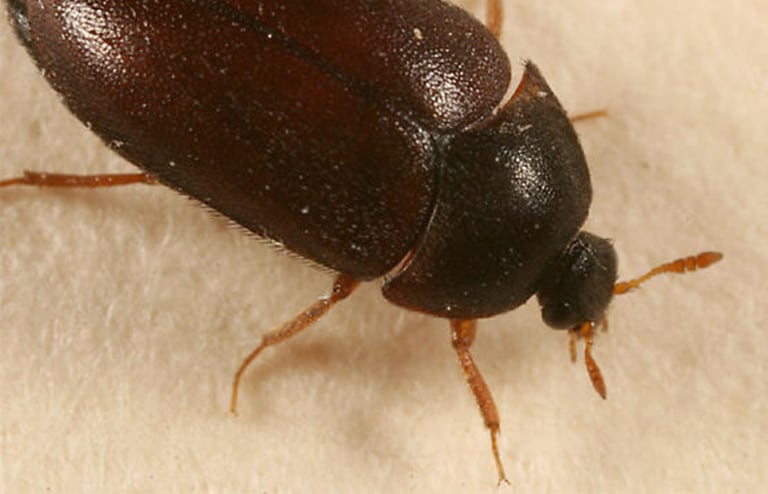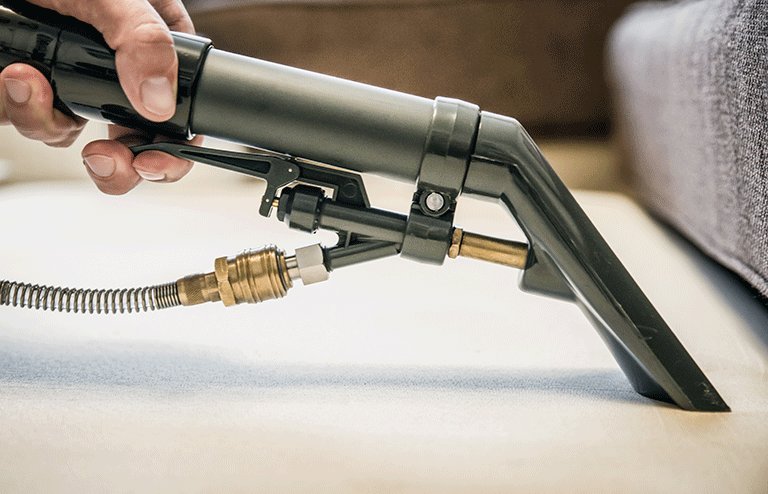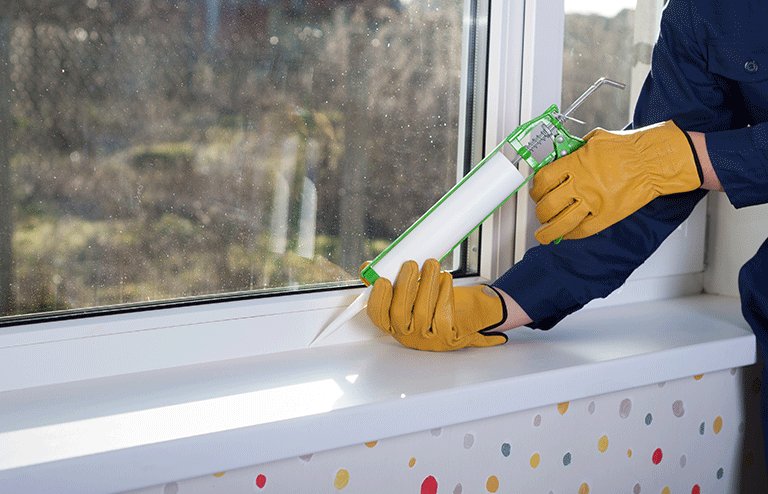Best Ways to Detect and Treat Carpet Beetles

Trying to get rid of beetles for good?
Get a FREE Quote & BEST PRICE from a local exterminator
(866) 470-1609Available Next Day
No Obligation Assessment
Guarantee Results
Appearance
So, what do carpet beetles look like? During the lifecycle of a carpet beetle, the appearance will vary dramatically. They begin life as an egg, then move on to the larval stage and the pupal stage, before emerging as adult beetles. Depending on the exact species of beetle, they reproduce from one to four times a year.
Beetles will usually lay eggs in batches of three, laying anything between 60 to 300 eggs in total. Be on the lookout in the warmer seasons for clusters of eggs. Female beetles tend to lay their eggs inside where there is ample food for the eggs to develop. The eggs are white or cream in color, dependent on the species, and will hatch in anything from five to 20 days.
The eggs are very small, measuring approximately 1/4 to 1/2 mm in length and have an oval shape. You may be able to see protrusions that look like spines at one end of the eggs. The female beetle will have taken care to lay the eggs in areas, such as upholstery or in wardrobes, drawers and areas where there is dust, lint, or hair for the eggs to feed upon. It is unlikely that you will detect beetles at this stage as they are tiny, well hidden, and often blend in to the area they have been laid upon.
The larvae of carpet beetle vary from species to species; typically the larvae have coarse hair and are about 5 mm in length. They may have an oval or elongated shape and are usually a brown color with distinctive white and tan-colored stripes. Black carpet beetle larvae tend to be larger and darker with yellow coloring. You can notice hairs on both species along the body and the tail.
In terms of the lifecycle of a common carpet beetle, this is when the beetles are at their most damaging. This is when the larvae will eat through just about anything such as upholstered items, including leather. They are not fussy and will feed on dead insects and rodents, clothes, pet food, crumbs, and hair.
The larvae at this stage can move from one area to another seeking out sources of food. This is the stage when they can be more easily detected. Once the beetles become adults they will feed on pollen and nectar or can even eat through cereals and grain.
Once the common carpet beetles become adult insects, they measure around 3 to 5 mm in length. They have black heads and have brownish black wings.
Treating an Infestation of Carpet Beetles
Now that you have investigated and realize your house is infested with these bugs, the next stage is to go about ridding your home of the pests. Follow these steps and you will be well on your way to being beetle-free.
Step 1 Vacuum Carpets
To eradicate your home of carpet beetles, the first stage is to vacuum all the surfaces in your home. You will need to vacuum the carpet in every room, and you will also need to vacuum upholstery and curtains. You should concentrate on the areas where you noticed the infestation but do not forget other areas. You need to ensure that every surface has been treated. When you vacuum, you will remove the beetles entirely—whether or not they are at the egg or larvae stage.
In order for this treatment to be effective, it is best to vacuum several times each day. By doing this, you will be able to rid your home of any of the larvae as they re-emerge from dark hidden places.
To carry out this treatment, use the attachments that fix to your vacuum to get into all the nooks and crannies. Pull out the cushions from your sofa and thoroughly vacuum the base and sides.
Step 2 Wash Fabrics
If you have clothes and bedding that has been stored away in impenetrable airtight boxes then that is fine. All other fabrics need to be washed, which includes all clothes and bedding as well as your towels. It may take a few loads or more in your washing machine but it is worth it to free yourself once and for all of these destructive pests.
You can treat rugs, upholstery, and carpets by hiring a steam cleaner or alternatively hire a professional who will steam clean your home for you.
These two steps should be enough to remove all traces of beetles from your home however if, after a week or so you are still aware of a lingering infestation, then you will need to take further action to deal with the problem once and for all.

Trying to get rid of beetles for good?
Get a FREE Quote & BEST PRICE from a local exterminator
(866) 470-1609Available Next Day
No Obligation Assessment
Guarantee Results
Treatments for a Carpet Beetle Infestation
The most popular and recommended treatment for dealing with carpet beetles is Boric acid. It is available online and is a substance that is entirely harmless to humans. Sprinkle the powder around the home, leave for a while, and then simply vacuum away. Don’t leave the acid on carpets for more than two hours and also consider which surfaces and fabrics you apply the Boric acid. Boric acid is bleach and it may have the effect of whitening dark fabrics.
The most popular and recommended treatment for dealing with carpet beetles is Boric acid. It is available online and is a substance that is entirely harmless to humans.
In the case of dark fabrics, when you fear that Boric acid may cause damage by bleaching, instead you can use an insecticide. When choosing an insecticide, check the label of the product and make sure that it is an effective way to treat carpet beetles. Products that contain ingredients, such as chlorpyrifos, bendiocarb, and allethrin are all excellent choices for combating carpet beetles.
Whichever product you use, read the instructions carefully and follow them to the letter. Wear gloves and goggles if necessary, open windows, and keep humans and pets including birds and fish away from the home whilst you carry out the treatment.
On rare occasions, when these steps do not work, you may need to seek the help of a professional to eradicate your home from a particularly resilient infestation.
Carpet Beetle Prevention
Now that you have rid your home of these pests don’t risk a further infestation by following these preventative measures:
Step 1 Keep it Clean
The easiest way to prevent a further infestation is to keep your home clean which will remove food sources for hungry beetle larvae. Vacuum frequently and consider steam cleaning fabrics, rugs, carpets, and upholstery so that hair and skin cells are removed.
Step 2 Seal Cracks
Check your home for cracks that beetles could use to enter your home and make any repairs where you see any possible entry for beetle larvae.
Step 3 Close Doors and Windows
Keeping doors and windows closed is a way to stop beetles entering your home. If leaving your windows open is necessary during warmer days, you can invest in screens for doors and windows.
Step 4 Buy Synthetic Materials
Carpet beetles will eat their way through most substances, but they only eat organic materials. So, if you want to take additional measures then choose synthetic products when furnishing your home.
The Symptoms of Carpet Beetle Allergies
For the most part, carpet beetles cause damage to the home at the larvae stage but they can cause allergies for some humans. Symptoms vary but usually, a person with an allergy to carpet beetles will experience redness and itchiness. The sensation is similar to a mosquito bite and the itch can be painful and difficult to ease.
The itching can spread to other parts of the body including the hands and legs. Rashes can appear and, as the itching can be quite painful, it can affect daily routines and cause sleep disturbances.
Treating Carpet Beetle Allergies
The treatment for carpet beetle allergies depends on how the individual is affected. The main problem associated with this kind of allergy is the intense and painful itching. To deal with this most common side-effect, you can use a sting swab. These swabs will provide relief for the itch and they also aid healing.
For soreness around the affected area, a simple and traditional method that will calm and soothe the area is calamine lotion that is available in pharmacies and stores.
You can also try ointments such as cortisone or a Benadryl lotion or cream. Once again, these remedies will help with the itching while promoting healing.
You can also make a cold compress by taking ice or packs of frozen vegetables from your freezer. Wrap them in a clean towel and apply to the sore, itchy area. This is an entirely natural method and numbs the area whilst soothing the maddening itch.
In more serious cases, or when these methods are not effective, you should seek the advice of a dermatologist. A dermatologist will be able to prescribe more potent lotions or may suggest steroid shots, in some cases. You should also consider your pets. Carpet beetles love to eat hair and fur and they are particularly attracted to dogs, but will also feed on cat hair too.
If your pet is scratching a lot, then it may have a carpet beetle allergy too. You can treat pets with a bath using a Melaluca shampoo or consider a topical ointment from your veterinarian.
We hope you found this guide helpful and you and your home stay beetle-free.

Trying to get rid of beetles for good?
Get a FREE Quote & BEST PRICE from a local exterminator
(866) 470-1609Available Next Day
No Obligation Assessment
Guarantee Results




